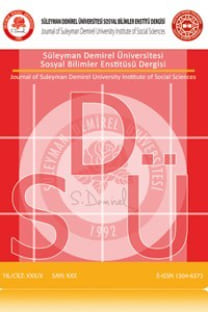GENÇ TÜKETİCİLERİN MARKA KİŞİLİĞİ ALGILAMALARININ CİNSİYETE GÖRE DEĞERLENDİRİLMESİ:MCDONALD’S VE BURGER KING
Marka Kişiliği, Marka kişiliği ölçeği, Hızlı Tüketim Restoranları
THE PERCEPTION OF BRAND PERSONALITIES OF FAST-FOOD RESTAURANTS BY YOUTH: MCDONALD’S AND BURGER KING
___
- Aaker D. A. (2009). Güçlü markalar yaratmak, Çeviren: Erdem DEMİR, İstanbul: Mediacat, Aaker J. L. (1996). Exploring Brand Equity: Building Strong Brands, New York: The Free Pres.
- Aaker, J. L. (1997). Dimensions of brand personality. Journal of Marketing Research, 34, 347−356.
- Aaker, J. L. (2000). Accessibility or diagnosticity? Disentangling the influence of culture on persuasion processes and attitudes. Journal of Consumer Research, 26, 340−356.
- Aaker, J. L., Benet-Martinez, V. ve Garolera, J. (2001). Consumption of symbols as carriers of culture: A study of Japanese and Spanish brand personality constructs. Journal of Personality and Social Psychology, 81, 492−508
- Austin, J. R., Siguaw, J. A. veMattila, A. S. (2003). A re-examination of the generalizability of the Aaker brand personality measurement framework. Journal of Strategic Marketing, 11, 77−92.
- Batra, R., Lehmann, D. R., et Singh, D. (1993). The Brand personality component of brand goodwill: some antecedents and consequences, Brand Equity and Advertising, editions Aaker et Biel, Hillsdale, NJ: LawrenceErlbaum associates, 83-96
- Borça, G. (2004). Bu Topraklardan Dünya Markası Çıkar mı? Marka Olmanın ABC’si. İstanbul: Media Cat.
- Bosnjak, M., Bochmann, V. ve Hufschmidt, T. (2007). Dimensions of brand personality attributions: A person-centric approach in the German cultural context. SocialBehavior and Personality, 35, 303−316.
- Caprara, G. V., Barbaranelli, C. ve Guido, G. (2001). Brand personality: How to make the metaphor fit? Journal of Economic Psychology, 22, 377−395.
- D'Astous, A. ve Lévesque, M. (2003). A scale for measuring store personality. Psychology & Marketing, 20, 455−469.
- Denli, N. (2007). Giyim Sektöründe Marka İmajı Odaklı İletişim Stratejileri, Ankara Üniversitesi Sosyal Bilimler Enstitüsü, Halkla ilişkiler ve Tanıtım Anabilim Dalı, Yayınlanmamış Yüksek lisans tezi, Ankara.
- Davies, G., Chun, R., Vinhas da Silva, R., ve Roper, S. (2004). A corporate character scale to assess employee and customer views of organization reputation. Corporate Reputation Review, 7, 125−146.
- Escalas, J. E. ve Bettman, J. R. (2005). Self-Construal, Reference Groups and Brand Meanning, Journal of Consumer research, 32, 378-89.
- Geuens, M., Weijters, B. ve De Wulf, K. (2009). A new measure of brand personality. International Journal of Research in Marketing, 26, 97107.
- Ferrandi, J. M., Valette-Florence, P. ve Fine-Falcy, S. (2000). Aaker's brand personality scale in a French context: A replication and preliminary test of validity. In H. E. Spotts, & H. L. Meadow (Eds.), Developments of marketing science, Vol. 23. (pp. 7−13) Montreal: Academy of Marketing Science.
- Helgeson, J. G., ve Supphellen, M. (2004). A conceptual and measurement comparison of self-congruity and brand personality. International Journal of Market Research, 46, 205−23
- Hosany, S., Ekinci, Y., & Uysal, M. (2006). Destination image and destination personality: An application of branding theories to tourism places. Journal of Business Research, 59, 638−642.
- Keller, K. L. (1993). Conceptualizing, Measuring and Managing CustomerBased Brand Equity,Journal of Marketing, 57,1-22
- Kim, C.K., Han, D. ve Park, S.B.(2001).The Effect of Brand Personality and Brand Identification on Brand Loyalty: Applying of Social Identification, Japanese Psychological Research,43, 195-206.
- Markalaşma Stratejileri http//www.stratejikfokus.com/images/do Erişim Tarihi: 14.09.2009
- Milas, G., ve Mlačić, B. (2007). Brand personality and human personality: Findings from ratings of familiar Croatian brands. Journal of Business Research, 60, 620−626. Ogilvy,D. (1983).Ogilvy on Advertising,New York: Crown Publishing
- Park, S., Choi, D. ve Kim J. (2005). Visualizing E-Brand Personality: Exploratory Studies on Visual Attributes and E-Brand Personalities in Korea, International Journal of Human-Computer Interaction, 19, 7-34.
- Phau, I. ve Lau, K. C. (2000). Conceptualising Brand Personality: A Review and Research Propositions, Journal of Targeting, Measurement and Analysis for Marketing, 9, 52-69.
- Smit, E. G., van den Berge, E., ve Franzen, G. (2002). Brands are just like real people! The development of SWOCC's brand personality scale. In F. Hansen, & L. B. Christensen (Eds.), Branding and Advertising (pp. 22−43). Copenhagen: Copenhagen Business School Press.
- Sung, Y., & Tinkham, S. F. (2005). Brand personality structures in the United States and Korea: Common and culture-specific factors. Journal of Consumer Psychology, 15, 334−350.
- Supphellen Magne and Kjell Gronhaug (2003), Building Foreign Brand Personalities in Russia: The Moderating Effect of Consumer Ethnocentrism, International Journal of Advertising, 22, 203-226.
- Tığlı, M. (2003).Marka Kişiliği, Öneri Dergisi, 5, 67-72.
- Torlak, Ö. ve Uzkurt, C. (2005). Kola Markası Kişiliklerinin Üniversite Öğrencileri Tarafından Algılanması, Dokuz Eylül Ünivesitesi İşletme Fakültesi Dergisi, 6,15-31
- Yayın Aralığı: Yılda 3 Sayı
- Başlangıç: 2005
- Yayıncı: Süleyman Demirel Üniversitesi
ZİNA HAKKINDAKİ BİR ÂYETİN İLETİŞİM PSİKOLOJİSİ AÇISINDAN TAHLİLİ
TÜRKİYE’DEKİ TEKNOKENTLERİN MEVCUT DURUMUN İNCELENMESİ
YÖNETİCİYE BAĞLILIKTA YÖNETİCİYE GÜVENİN ETKİSİ: YAPISAL EŞİTLİK MODELİ İLE BİR ANALİZ
Fatma Başalan İZ, Tangül Aytur ÖZEN
Haluk TANRIVERDİ, Orhan ADIGÜZEL, Münire ÇİFTÇİ
KÜRESEL EKONOMİK KRİZİN ÇİN EKONOMİSİNE ETKİLERİ: ÇİN’İN BÜYÜME STRATEJİSİNİN SÜRDÜRÜLEBİLİRLİĞİ
BİLÂL EFENDİ’NİN KISSA-İ YÛSUF U ZELÎHÂ’SININ TUNUS NÜSHASI
DEVLET MUHASEBE SİSTEMİ ALANINDA YAŞANAN GELİŞMELERİN ÜLKE DENEYİMLERİ AÇISINDAN DEĞERLENDİRİLMESİ
